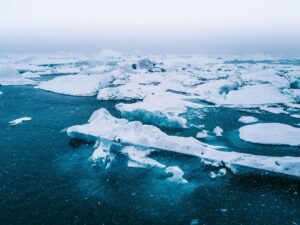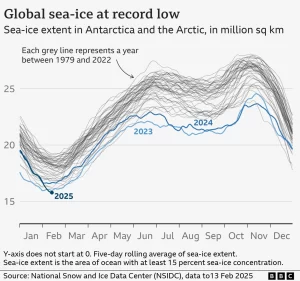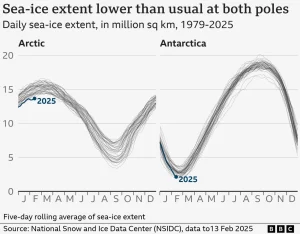The world is facing another warning signal of the climate crisis. Satellite measurements show that the planet's polar regions are covered in less sea ice than at any time in recorded history. This loss of a natural protective shield that reflects sunlight back into space is accelerating global warming and threatening not only life in the Arctic and Antarctic but also climate stability across the planet.
July 8, 2025
Mark Poynting, Erwan Rivault, BBC Climate & Verify Data Journalism Teams
Satellite measurements show that the extent of sea ice covering our planet's North and South Poles has fallen to its lowest level on record, an alarming trend that is fueling growing concerns about the effects of climate change.
Sea ice acts like a giant mirror, reflecting much of the sun's radiation back into space. This helps regulate the planet's temperature and maintain a stable climate. But as temperatures rise and the ice melts, the exposed dark ocean water absorbs more heat, leading to further warming—a dangerous, self-reinforcing cycle.

Lowest recorded ice extent
According to a BBC analysis based on data from the US National Snow and Ice Data Centre (NSIDC), in the five days to February 13, 2025, the combined extent of sea ice in the Arctic and Antarctic was just 15.76 million square kilometersThis is less than the previous low. 15.93 million km² measured at the beginning of 2023.
In the Arctic, sea ice extent is currently at its lowest ever recorded for this time of winter, while in Antarctica, sea ice extent is approaching its historic low since the late 1970s.

Why is ice disappearing?
Experts attribute this decline to a combination of several factors: above-average warm air, a warming ocean, and winds that break up the continuous ice sheet.
In Antarctica, which is surrounded by ocean, sea ice is naturally thinner and more mobile than in the Arctic. This means it is more sensitive to weather conditions and can break and drift away more easily. In addition, this season has seen exceptionally high temperatures, according to scientists, which led to strong surface melting on land glaciers - so-called ice shelves.
"Each new data point suggests that this is not a short-term fluctuation, but a more permanent change, similar to what we have been observing in the Arctic for a long time," warns Walter Meier, a senior researcher at NSIDC.
Antarctica is losing its resilience
While Arctic sea ice loss has been predicted for decades in the context of global warming, Antarctica has long been an exception. Until the mid-2010s, sea ice extent there fluctuated without a clear downward trend. Since then, scientists have recorded repeated record lows.
Scientists from the British Antarctic Survey say extreme temperatures, particularly in December and January, have driven intense melting of ice shelves. These processes, combined with warming oceans, have contributed to record low sea ice extent during the Southern Hemisphere summer.
A recent study found that the record loss of Antarctic sea ice in 2023 would have been an extreme, once-in-2,000-year event without human influence on the climate. Yet just two years later, we are approaching its repeat, suggesting that this is the new climate normal.

Arctic also at historic low
On the other side of the planet, where winter should be at its peak and ice at its maximum right now, we see the opposite trend. The extent of Arctic ice is almost 200,000 km² lowerthan ever before recorded at this time of winter.
This is due not only to prolonged heat in areas like Hudson Bay, where the water has cooled more slowly than usual, but also to storms that have broken up the ice in the Barents and Bering Seas. Long-term thinning of the ice cover also plays a role - thinner ice is more fragile and sensitive to short-term weather fluctuations.
In some areas of the Arctic, such as the Spitsbergen archipelago, temperatures reached values of up to 20°C higherthan the long-term average – which caused unusual winter melting.
Implications for the planet
The loss of sea ice has far-reaching consequences that extend beyond the polar regions. The reduction of this reflective layer leads to a decrease in the Earth's albedo - the ability of the surface to reflect sunlight. Since the 1980s, the polar regions have lost approximately 14 % its natural cooling ability, which means the planet is now warming even faster.
Sea ice is also a key element of the so-called global ocean belt (Great Ocean Conveyor Belt) – a system of ocean currents that distribute heat across the planet. Any disruption to this system could have serious consequences for the temperate climate of areas such as northwestern Europe.
"If we see a massive loss of Antarctic ice this winter, experts will start to seriously analyze what impact this might have on global ocean circulation," warns Professor Simon Josey of the National Oceanography Centre.
Endangered fauna and an ice-free future
The loss of ice also threatens polar ecosystems. Animals such as polar bears and emperor penguins are directly dependent on sea ice for their existence – whether for food, rest or reproduction.
According to the UN Intergovernmental Panel on Climate Change (IPCC), the Arctic is expected to will be virtually free of sea ice some summer before 2050Some recent studies suggest that this moment may come even sooner if global warming is not stopped.

The retreat of sea ice is opening up new shipping routes, particularly through the Northern Sea Route off Russia and the Northwest Passage in Canada. While this brings economic benefits in the form of shorter shipping routes between Asia and Europe, it is also contributing to further warming of the Arctic. Ships are breaking up the thin ice, stirring up warmer ocean layers and further weakening this sensitive ecosystem with their emissions. The growing shipping traffic is also bringing pollution, noise and threats to species that depend on the polar environment for their survival – from whales to polar bears to fragile marine communities.
Scientists have also seen unusually strong melting of the Antarctic ice shelves. These huge slabs of ice that extend from the mainland glacier into the sea serve as a natural barrier to prevent inland ice from rapidly sliding into the ocean. But in recent months, widespread melting of the surface layer has weakened shelves like Larsen C and Amery, increasing the risk of their collapse. If these ice masses break away, sea levels will rise at an accelerated rate.
The decline in sea ice also affects the global ocean circulation, known as the Great Ocean Conveyor Belt. These currents help maintain a balanced distribution of heat across the planet. When the salinity and temperature of the water in the polar regions change, this can weaken this system. This would have far-reaching consequences – for example, northwestern Europe could cool down or monsoon cycles in Asia could be disrupted, affecting the agriculture of billions of people.
Scientists are also concerned about the loss of consistent sea ice data. The US is planning to retire one of its key satellites that has long monitored the polar regions. Although new satellites are being prepared, the transition between them could cause data gaps and disrupt the continuity of more than 40 years of measurements. This data is the basis for monitoring climate trends and providing early warning of further changes that have a global impact.
Current developments in the polar regions are another clear sign that the climate crisis is accelerating. Experts warn that unless significant steps are taken to reduce greenhouse gas emissions and slow global warming, we will lose one of the planet's most important natural defenses.
